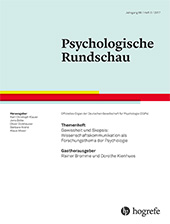Der Einfluss von Abbildungen auf das Verstehen von und Vertrauen in wissenschaftsbasierte Informationen
Abstract
Zusammenfassung. In der Wissenschaftskommunikation sind Abbildungen allgegenwärtig. Zumeist handelt es sich dabei um Fotos, um beschriebene Sachverhalte zu veranschaulichen und Diagramme, um Forschungsergebnisse zu visualisieren. Somit stellt sich die Frage nach der Wirkung, die solche Abbildungen auf das Verstehen wissenschaftsbasierter Aussagen haben. Eine besondere Rolle scheint dabei dem Vertrauen in die kommunizierten Inhalte zuzukommen. Um diesen komplexen Zusammenhang zu modellieren, ist die Verzahnung von Wissenschaftskommunikation und psychologischer Forschung notwendig.
Abstract. In science communication, the use of pictures is omnipresent. In many cases it involves (a) realistic pictures (mostly photographs) to illustrate matters or (b) graphs (e. g., line graphs) to visualize quantitative–empirical results. This raises the question of the effect that such pictures exert on the comprehension of the provided information. In this context, the trust in the communicated content seems to play a special role. Cooperation between science communication and psychological research is needed to model this complex relationship.
Literatur
(2006). Visual inscriptions in the scientific hierarchy: Mapping the treasures of science. Scientific Communication, 27, 376 – 428.
(2009). Trust matters: Examining the role of source evaluation in students’ construction of meaning within and across multiple texts. Reading Research Quarterly, 44, 6 – 28.
(2014). The Public’s Bounded Understanding of Science. Educational Psychologist, 49, 59 – 69. doi: 10.1080/00461520.2014.921572
(2014).
Wissenschaftsverständnis und Wissenschaftskommunikation . In T. SeidelA. KrappHrsg..Pädagogische Psychologie (6. Aufl., S. 55 – 81). Weinheim: Beltz.(2010).
Who knows what and who can we believe? Epistemological beliefs are beliefs about knowledge (mostly) attained from others . In L. D. BendixenF. C. FeuchtEds., Personal epistemology in the classroom: Theory, research, and implications for practice (pp. 163 – 193). Cambridge: Cambridge University Press.(1983). Strategies of discourse comprehension. New York: Academic Press.
(1989). Effects of seductive details on macroprocessing and microprocessing in adults and children. Cognition and Instruction, 6, 41 – 57.
(2012). Comprehending and learning from internet sources: Processing patterns of better and poorer learners. Reading Research Quarterly, 47, 356 – 381.
(1998). How seductive details do their damage: A theory of cognitive interest in science learning. Journal of Educational Psychology, 90, 414 – 434.
(2013). Neuroscientific information bias in metacomprehension: The effect of brain images on metacomprehension judgment of neuroscience research. Psychonomic Bulletin & Review, 20, 1357 – 1363.
(2013). Comprehending conflicting science-related texts: Graphs as plausibility cues. Instructional Science, 41, 849 – 872.
(2016). The role of decorative pictures in comprehending science-related texts on the internet. Manuscript submitted for publication.
(1994). Elements of graph design. New York: W. H. Freeman.
(1989). Neue Ansätze einer pädagogisch orientierten Interessenforschung. Empirische Pädagogik, 3, 233 – 255.
(1987). Why a diagram is (sometimes) worth ten thousand words. Cognitive Science, 11, 65 – 99.
(1990).
Drawing things together . In M. LynchS. WoolgarEds., Representation in scientific practice (pp. 19 – 68). Cambridge, MA: MIT Press.(2009). Visuelle Wissenskommunikation: Effekte von Bildern beim Lernen (Schriften zur pädagogischen Psychologie, Bd. 38). Hamburg: Dr. Kovac.
(2013). The role of decorative pictures in learning. Instructional Science, 41, 811 – 831.
(1993). Effects of signaling topic structure on text recall. Journal of Educational Psychology, 85, 281 – 290.
(2014). Informal Learning Through Science Media Usage. Educational Psychologist, 49, 86 – 103.
(2008). Seeing is believing: The effect of brain images on judgments of scientific reasoning. Cognition, 107, 343 – 352.
(1975). The organization of prose and its effects on memory. Amsterdam: North Holland.
(2012). Non-probative photographs (or words) inflate truthiness. Psychonomic Bulletin & Review, 19, 969 – 974. doi: 10.3758/s13423-012-0292-0
(1986). Communication and persuasion: Central and peripheral routes to attitude change. New York: Springer.
(1998).
Attitude change: Multiple roles for persuasion variables . In D. T. GilbertS. T. FiskeG. LindzeyEds., Handbook of social psychology (4th ed., Vol. 1, pp. 323 – 390). New York: McGraw-Hill.(1994). Interaction of media, cognition, and learning. Hillsdale, NJ: Erlbaum.
(2012). The seduction of easiness: How science depictions influence laypeople’s reliance on their own evaluation of scientific information. Learning and Instruction, 22, 231 – 243.
(1986). Three components of understanding a programmer’s manual: Verbatim, propositional, and situational representations. Journal of Memory and Language, 25, 279 – 294.
(1994).
Wissenserwerb mit logischen Bildern . In B. WeidenmannHrsg., Wissenserwerb mit Bildern (S. 95 – 147). Bern: Huber.(2005).
An integrated model of text and picture comprehension . In R. E. MayerEd., Cambridge Handbook of Multimedia Learning (pp. 49 – 69). Cambridge: Cambridge University Press.(2003). Construction and interference in learning from multiple representations. Learning and Instruction, 13, 141 – 156.
(2014). Addressing challenges to public understanding of science: Epistemic Cognition, Motivated Reasoning, and Conceptual Change. Educational Psychologist, 49, 123 – 138. doi: 10.1080/00461520.2014.916216
(2002). Constructing knowledge: The role of graphs and tables in hard and soft psychology. American Psychologist, 57, 749 – 761.
(2000). Scientific graphs and the hierarchy of the sciences: A Latourian survey of inscription practices. Social Studies of Science, 30, 73 – 94.
(1983). The visual display of quantitative information. Cheshire, Cn: Graphics Press.
(2012). Kognitionspsychologische Aspekte der Bild-Text-Integration. Psychologische Rundschau, 63, 11 – 17.
(2002).
Exemplification theory of media influence . In J. BryantD. ZillmannEds., Media effects: Advances in theory and research (2nd ed., pp. 19 – 41). Mahwah, NJ: Erlbaum.



